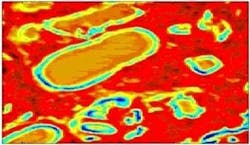Gooch & Housego MINERVA project wins SPIE Photonics Europe village award
The Gooch & Housego (G&H)-led MINERVA (http://minerva-project.eu/) (MId- to NEaR infrared spectroscopy for improVed medical diAgnostics) project has won an around $2078 dollar award (1500€) prize at SPIE's recent Photonics Europe conference in Brussels. The award, in the Photonics Innovation Village, was for “Best Innovation by a Multilateral Project, Organization or Company” and was accepted on behalf of G&H and other participants by G&H Research Engineer Gary Stevens.
RELATED ARTICLE: All-fiber designs extend supercontinuum sources into the mid-IR region
The MINERVA project is funded with about $10.1 million dollars (7.3 M €) under the European Commission's Seventh Framework Program (FP7-ICT) and runs from November 2012 until October 2016. In recent years it has become clear that mid-IR imaging spectroscopy has the potential to open a new chapter in biomedical imaging and offers an effective tool for early cancer diagnosis and improved survival rates.
Rather than a search for "cancer marker" absorption peaks, great progress has been made by analyzing the entire bio-molecular mid-IR spectral signature using automated algorithms. However, the lack of suitable sources, detectors and components has restricted the technology to one of academic interest, based on weak thermal sources, low power lasers or synchrotron research tools. For the first time the photonic technology is in place to develop a new mid-IR technology platform on which entirely novel supercontinuum sources (1000X brighter than thermal sources) covering the whole range from 1.5 to 12 μm.
Clinical trials of a MINERVA based system will start within the next few months although the goal of developing an in vivo scanning system to probe patients is still some way off.
According to Professor Nicholas Stone, professor of Biomedical Imaging and Biosensing at the University of Exeter's School of Physics: "The field of vibrational spectroscopy applied to medicine is rapidly advancing and many groups have now demonstrated the capability of mid-infrared imaging to identify subtle disease specific changes in the molecular composition of tissues and cells. The MINERVA project will take this technique to the next level by enabling it to be utilized much more rapidly, by developing bright IR sources and sensitive detector arrays we expect to be able to capture diagnostic images of unstained tissues and cells in a matter of seconds. In addition clever data analysis methods will allow the image to be superimposed on each other and standard histopathology images of the same sample. The potential for revolutionizing the current methods of clinical diagnosis are huge."
The MINERVA project runs until 2015 and is led by optical technology providers Gooch & Housego. Other participants include: BBT Materials Processing SRO, Danmarks Tekniske Universitet, Gloucestershire Hospitals NHS Foundation Trust, IRNOVA AB, LISA Laser Products OHG, NKT Photonics A/S, Universitat Politècnica de València, University of Exeter, University of Nottingham, Vivid Components, Westfälische Wilhelms-Universität Münster, Xenics NV.
SOURCE: Gooch & Housego; http://www.goochandhousego.com/press_release/gooch-housego-lead-minerva-mid-to-near-infrared-spectroscopy-for-improved-medical-diagnostics-project-wins-photonics-innovation-village-award-at-photonics-europe/

Gail Overton | Senior Editor (2004-2020)
Gail has more than 30 years of engineering, marketing, product management, and editorial experience in the photonics and optical communications industry. Before joining the staff at Laser Focus World in 2004, she held many product management and product marketing roles in the fiber-optics industry, most notably at Hughes (El Segundo, CA), GTE Labs (Waltham, MA), Corning (Corning, NY), Photon Kinetics (Beaverton, OR), and Newport Corporation (Irvine, CA). During her marketing career, Gail published articles in WDM Solutions and Sensors magazine and traveled internationally to conduct product and sales training. Gail received her BS degree in physics, with an emphasis in optics, from San Diego State University in San Diego, CA in May 1986.
